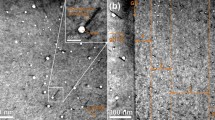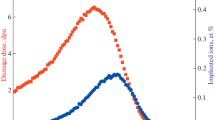Abstract
Data are presented on the variations in dimensions and form of uranium specimens during irradiation. It is shown that by regulating the composition of the uranium and treatment conditions (degree of deformation in theα-region and heat-treatment conditions), in consequence of variation in grain size and texture, it is possible to vary within wide limits the magnitude of surface distortion due to irradiation and the value of Gi.
A study has been made of the dependence of the variation in grain size of quenched uranium, as well as hardness, tensile strength, and yield strength, on the iron, silicon, and aluminum content of uranium. The cooling rate and content of these impurities influence the critical point of theΒ→α transformation on quenching; for example, for a cooling rate of 400‡C/ sec and a silicon content of 0.05%, the critical point of theΒ→α transformation drops to 530‡C.
Experimental results show a creep acceleration during irradiation (nv = 6·1012 neutr/cm2·sec) of 50–100 times, i.e., by 1.5–2 orders for textured uranium and uranium with disoriented structure. The rate of creep of uranium with a disoriented structure is connected to the burnup rate.
The results are given of tensile tests made on uranium directly in the reactor. Even after remaining a short time in the neutron field (up to 1 hour), the percentage elongation is diminished somewhat and the tensile strength is increased.
Similar content being viewed by others
Literature cited
S. T. Konobeevskii, N. F. Pravdiuk and V. I. Kutaitsev, Investigations in the Fields of Geology, Chemistry and Metallurgy. Reports of the Soviet Delegation at the International Conference on Peaceful Uses of Atomic Energy (AN SSSR Press, 1955) p. 263.
S. F. Pugh, Damage Occurring in Uranium during Burnup, Report No. 443 of Great Britain at the International Conference on the Peaceful Uses of Atomic Energy, Geneva, 1955.
S. H. Paine and I. H. Kittel, Irradiation Effects In Uranium and Its Alloys, Report No. 745 of Representatives of the USA at the International Conference on the Peaceful Uses of Atomic Energy, Geneva, 1955.
F. G. Foote, Physical Metallurgy of Uranium, Report No. 555 of the USA at the International Conference on the Peaceful Uses of Atomic Energy, Geneva, 1955.
I. P. Howe, Metallurgy of Reactor Fuel, Report No. 825 of the USA at the International Conference on the Peaceful Uses of Atomic Energy, Geneva, 1955.
R. Duwez, J. Appl. Phys. 24, No. 2, 152 (1953).
D. W. White, J. Metals 7, 11, 1221 (1955).
A. H. Cottrell, Metals Rev. 1, 479 (1956).
A. C. Roberts and A. H. Cottrell, Phil. Mag. 1, 711 (1956).
H. C. Rose, J. Inst. Metals 86 (3), 122 (1957).
Engineering 183, 4750, 380 (1957).
R. E. Hueschen, R. S. Kemper and W. S. Kelly, Second Nucl. Eng. Sci. Conference, paper 57 - NESC-13, USA, 1957.
Additional information
The following assisted in the experimental work: A. G. Lanin, V. M. Teplinskaia, V. K. Zakharova, L. N. Protsenko, V. N. Golovanova and K. A. Borisov.
Rights and permissions
About this article
Cite this article
Zaimovskii, A.S., Sergeev, G.I., Titova, V.V. et al. Influence of the structure and properties of uranium on its behavior during irradiation. At Energy 5, 1305–1313 (1959). https://doi.org/10.1007/BF02276887
Received:
Issue Date:
DOI: https://doi.org/10.1007/BF02276887




